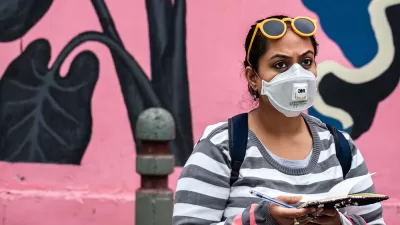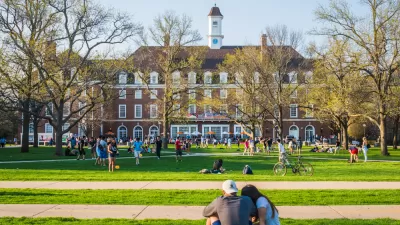As college students return for the fall semester, college towns are rightfully concerned about an influx of COVID cases, yet self-contained campuses have the potential to succeed where local and state governments may have failed.

Just as college campuses can be ideal environments to promote alternative transportation strategies, often running their own transit systems, charging for student parking, and even prohibiting freshman from owning cars, so too can they effectively deploy COVID-containment strategies, provided the motivation and leadership are present.
As noted in a recent post on coronavirus cases spiking in the Midwest, a Grand Forks public health official "said upwards of about 75% of the recent spate of new cases are the result of University of North Dakota students returning to campus." The Grand Forks Herald also observed that the university did not require students to get tested prior to arriving on campus, nor once they arrived on campus. Contrast that approach with Penn State University.
"As part of a layered detection and mitigation approach, Penn State will begin on Aug. 24 to conduct a randomized COVID-19 surveillance testing program University-wide to identify asymptomatic carriers of the virus and monitor the prevalence of COVID-19 across all campuses," begins a University press release (source article) from Penn State on Aug. 21. "The University will perform daily testing of at least 1% of the student, faculty and staff population across Penn State’s campuses."
Centers for Disease Control and Prevention alters testing guidance
The same day that Penn State began its randomized COVID-19 surveillance testing program to identify asymptomatic carriers, the CDC not only indicated that people without symptoms need not be tested, but even if they were exposed to known carriers, they need not be tested. Tom Frieden, who ran the CDC from 2009-2017, told the PBS Newshour that "it's really not defensible to say that asymptomatic contacts should not be tested." The American Medical Association called it "a recipe for community spread and more spikes in coronavirus."
As for mask mandates, Bill Schackner, the Pittsburgh Post-Gazette's higher education writer, reported on Aug. 20 on the performance of the university's “Mask Up or Pack Up" campaign.
Penn State is the latest high-profile university to warn students that reopening plans are being jeopardized by students partying and otherwise shunning social distancing rules. A day earlier, the University of Pittsburgh’s dean of students, Kenyon Bonner, said as much.
The University of Pittsburgh also runs a surveillance testing program, and the results are encouraging. "Since Aug 12, 1,225 students have been tested, with a positivity rate of 0.16%," reported Schackner on Aug. 24. The state with the lowest positivity rate on Aug. 27 was Vermont at 0.49%, according to the Johns Hopkins Coronavirus Resource Center.
How well is your college or university doing?
"A New York Times survey of more than 1,500 American colleges and universities — including every four-year public institution...has revealed at least 26,000 cases and 64 deaths since the pandemic began," according to a new college coronavirus tracker launched by the Times on Aug. 26. Scroll down to "Search for a school" and type the name in the box.
FULL STORY: Random surveillance testing begins for Penn State students, employees

Alabama: Trump Terminates Settlements for Black Communities Harmed By Raw Sewage
Trump deemed the landmark civil rights agreement “illegal DEI and environmental justice policy.”

Planetizen Federal Action Tracker
A weekly monitor of how Trump’s orders and actions are impacting planners and planning in America.

The 120 Year Old Tiny Home Villages That Sheltered San Francisco’s Earthquake Refugees
More than a century ago, San Francisco mobilized to house thousands of residents displaced by the 1906 earthquake. Could their strategy offer a model for the present?

In Both Crashes and Crime, Public Transportation is Far Safer than Driving
Contrary to popular assumptions, public transportation has far lower crash and crime rates than automobile travel. For safer communities, improve and encourage transit travel.

Report: Zoning Reforms Should Complement Nashville’s Ambitious Transit Plan
Without reform, restrictive zoning codes will limit the impact of the city’s planned transit expansion and could exclude some of the residents who depend on transit the most.

Judge Orders Release of Frozen IRA, IIJA Funding
The decision is a victory for environmental groups who charged that freezing funds for critical infrastructure and disaster response programs caused “real and irreparable harm” to communities.
Urban Design for Planners 1: Software Tools
This six-course series explores essential urban design concepts using open source software and equips planners with the tools they need to participate fully in the urban design process.
Planning for Universal Design
Learn the tools for implementing Universal Design in planning regulations.
Clanton & Associates, Inc.
Jessamine County Fiscal Court
Institute for Housing and Urban Development Studies (IHS)
City of Grandview
Harvard GSD Executive Education
Toledo-Lucas County Plan Commissions
Salt Lake City
NYU Wagner Graduate School of Public Service




























